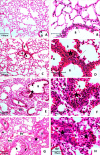Study of ethion and lipopolysaccharide interaction on lung in a mouse model
- PMID: 32742976
- PMCID: PMC7390112
- DOI: 10.1186/s42826-020-00055-z
Study of ethion and lipopolysaccharide interaction on lung in a mouse model
Abstract
Ethion is an organophosphate used commonly in India despite being banned in many other countries. The present study was designed to study the interaction of ethion and lipopolysaccharide (LPS) together on lung after single low dose ethion exposure. Mice (n = 20) were alienated into control and treatment groups (n = 10 each). The treatment group was orally fed ethion (8 mg/kg/animal/day) dissolved in corn oil. The animals (n = 5 each) from both the groups were challenged with 80 μg Escherichia coli lipopolysaccharide (LPS) intranasally and the remaining animals (n = 5 each) were administered normal saline solution after 24 h. Ethion along with LPS induced lung inflammation as indicated by increased neutrophils and total leukocyte count (TLC) in broncheoalveolar lavage fluid. Ethion induced histomorphological alterations in lung as shown by increased pulmonary inflammation score in histopathology. Real time PCR analysis showed that ethion followed by LPS resulted significant (p < 0.05) increase in pulmonary Toll-like receptor (TLR)-4 (48.53 fold), interleukin (IL)-1β (7.05 fold) and tumor necrosis factor (TNF)-α (5.74 fold) mRNA expression. LPS co-exposure suggested synergistic effect on TLR4 and TNF-α mRNA expression. Ethion alone or in combination with LPS resulted genotoxicity in blood cells as detected by comet assay. The data suggested single dietary ethion exposure alone or in conjunction with LPS causes lung inflammation and genotoxicity in blood cells.
Keywords: Ethion; Genotoxicity; IL-1β; Organophosphates; TLR-4; TNF- α.
© The Author(s) 2020.
Conflict of interest statement
Competing interestsThe authors declared no potential conflicts of interest with respect to the research, authorship, and/or publication of this article.
Figures







References
-
- Verma G, Ramneek, Mukhopadhyay CS, Sethi RS. Acute ethion exposure alters expression of TLR9 in lungs of mice. Ind J Vet Anat 2016;28(1):40–43.
LinkOut - more resources
Full Text Sources

